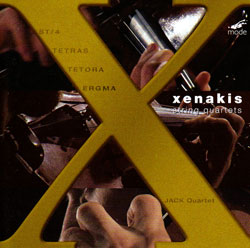
Xenakis' four string quartets are a fascinating distillation of his extraordinarily complex music — still very complex but with enough clarity afforded by the instrumentation to allow the less than experienced listener a glimpse into the mysteries of his often forbidding art.
The set opens with "Tetras" (1983) and one's first impression is less of arcane mathematica and more of an almost romantic sojourn down dark, swirling byways, tendril-filled, ghostly, with not a little George Crumb in the mix — in other words, surprisingly narrative in aspect. There are enough repeated phrases and attacks and glissandos galore as well as semi-regular rhythms to provide "earholds" for the innocent listener and to easily connote overarching form; no Brownian motion here! It's the rare modern piece that can be justifiably be called "ravishing", but this is one, thrillingly played by the JACK Quartet, unsparing on the necessary amount of bravado.
"Tetora" (1990) also retains romantic overtones but of a very different nature. The overt virtuosity of "Tetras" is replaced with brooding lines that coil themselves slowly, darkly, ophidically. The pitch relationships grade from rich to harsh, often straddling the two, Xenakis employing his "sieves" technique which produced harmonics in unusual, non-iterative intervals. Oddly, this results in certain sonic affinities with medieval musics, though the structures they're placed within are anything but. Still, there's a feeling of being pared-down compared to "Tetras", a whittling away of éclat but a retention of seriousness and forward propulsion. Only slight tongue-in-cheek, one might say it's everything a Gavin Bryars string quartet should have been.
The earliest quartet by far is 1956-62's "ST-4/1.080262" and it's also the most "Xenakis-sounding" of the four. Carved out of a work for larger ensemble, "ST-10", we hear the composer/mathematician in all his stochastic glory, the array of sounds situated in space via computer-generated formulae, creating hitherto unknown relationships and tension between pitches and timbres to occur. It's quite spacious, the sonic density varying from a miasma to near-silence. Any number of extended techniques are in evidence but they never overwhelm the music, instead fitting perfectly into the onrushing flux. A wonderful manifestation of the mathematical shown to be as natural as a flower. Again, rigorously and exactingly rendered by the JACK Quartet.
"Ergma" (1994) is closer to "Tetora" than to the other two quartets inasmuch as it eschews extended technical effects and glissandi, but it's far more brutal, more unrelenting. Commissioned by the Mondriaan Quartet and intended as an homage to that painter, Xenakis uses double-stops throughout, always at fff creating a kind of foursquare chorale, but a wrenching one, tortuously winding its way down a dimly lit, claustrophobia-inducing passageway. Beckett would have liked this one.
Comments and Feedback:



More Recent Reviews, Articles, and Interviews @ The Squid's Ear...


|

